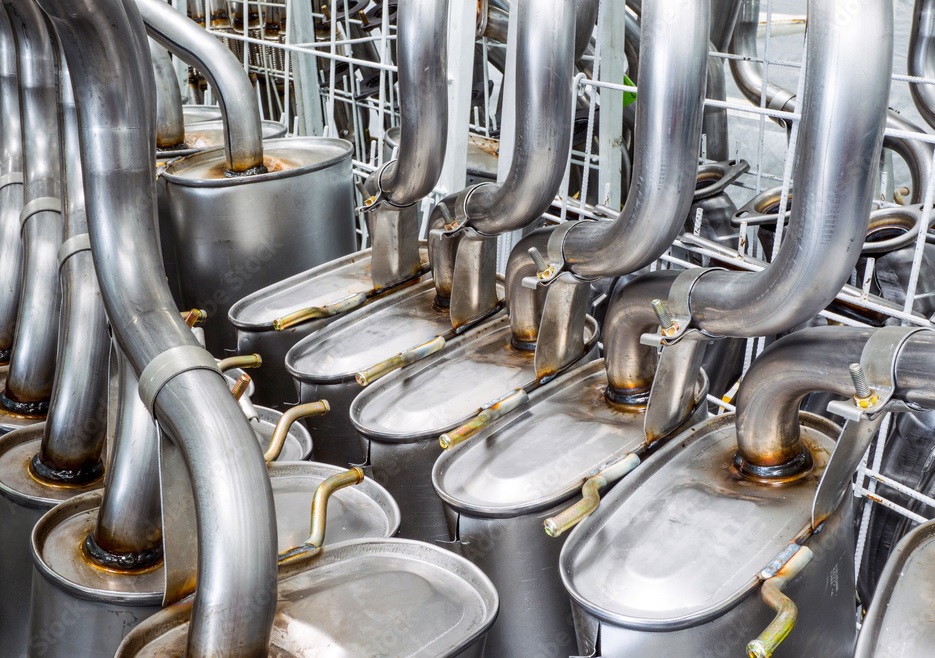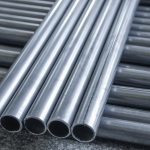In the world of automotive engineering, understanding the materials and construction of various components is crucial for ensuring optimal performance and longevity of vehicles. One common inquiry that arises among enthusiasts and mechanics alike is whether exhaust pipes are galvanized. Galvanization, a process involving the application of a protective zinc coating to steel or iron surfaces, plays a significant role in safeguarding against corrosion. This comprehensive guide explores the nuances of galvanized exhaust pipes, offering insights into their construction, benefits, considerations, and broader implications within the automotive industry.
Understanding Galvanized Exhaust Pipes
What is Galvanization?
Galvanization is a time-tested method utilized to protect steel or iron from rust and corrosion. The process entails coating the metal surface with a layer of zinc, which serves as a sacrificial anode, effectively preventing oxidation and extending the lifespan of the underlying material.
Construction of Galvanized Exhaust Pipes
Galvanized exhaust pipes are meticulously crafted from steel tubing that undergoes the galvanization process. This involves cleaning the surface to remove any impurities, followed by immersion in a bath of molten zinc or application of a zinc-rich coating. The resulting protective layer shields the exhaust pipes from corrosive elements present in exhaust emissions and environmental factors.
Galvanization Process
The galvanization process comprises several stages, each essential for ensuring the durability and effectiveness of the protective coating. After surface preparation, the metal is immersed in a molten zinc bath at temperatures exceeding 800°F (427°C), allowing the zinc to bond with the steel through a metallurgical reaction. Alternatively, the zinc coating may be applied through electroplating or spraying methods, offering versatility in application and thickness control.
Benefits of Galvanized Exhaust Pipes
Superior Corrosion Resistance
Galvanized exhaust pipes boast unparalleled resistance to corrosion, thanks to the protective zinc layer. This resilience enables them to withstand exposure to moisture, road salt, and other corrosive elements, ensuring longevity and reliability even in harsh driving conditions.
Extended Durability
The robust construction of galvanized exhaust pipes results in enhanced durability compared to traditional uncoated options. The zinc coating acts as a barrier, shielding the underlying steel from corrosion, abrasion, and impact damage, thereby prolonging the lifespan of the exhaust system.
Enhanced Performance
Galvanized exhaust pipes contribute to optimal performance of the vehicle’s exhaust system by maintaining structural integrity and minimizing the risk of leaks or cracks. This ensures consistent exhaust flow, reduces backpressure, and enhances overall engine efficiency, resulting in improved fuel economy and performance.
Environmental Sustainability
In addition to their performance benefits, galvanized exhaust pipes offer environmental advantages. Zinc, the primary component of the galvanized coating, is a naturally abundant metal that is fully recyclable. This makes galvanized materials an eco-friendly choice, aligning with sustainability initiatives and reducing environmental impact.
Considerations for Galvanized Exhaust Pipes
Compatibility with High Temperatures
While galvanized coatings provide excellent corrosion protection, they may experience degradation when exposed to high temperatures, such as those generated by exhaust gases. It is crucial to select galvanized exhaust pipes specifically designed to withstand elevated temperatures to ensure optimal performance and longevity.
Proper Installation and Maintenance
Proper installation and regular maintenance are essential for maximizing the effectiveness of galvanized exhaust pipes. This includes ensuring secure mounting, inspecting for signs of damage or deterioration, and promptly addressing any issues to prevent corrosion and maintain performance over time.
Applications Beyond Automotive Industry
Construction and Infrastructure
Galvanized steel finds widespread use in construction and infrastructure projects due to its durability and corrosion resistance. It is utilized in structural components, fencing, guardrails, and utility poles, among other applications, to ensure longevity and reliability in various environments. (See Also: Can You Use Galvanized Pipe for Exhaust? Tips & Risks Explained)
Industrial and Agricultural Equipment
Galvanized materials are also prevalent in industrial and agricultural equipment, where corrosion resistance is paramount. From machinery components to storage tanks and agricultural implements, galvanized steel offers robust protection against corrosion, extending equipment lifespan and reducing maintenance costs.
Galvanized vs. Stainless Steel
Composition and Properties
While both galvanized and stainless steel offer corrosion resistance, they differ in composition and properties. Galvanized steel is coated with a layer of zinc, while stainless steel contains chromium for corrosion resistance. Each material has its advantages and suitability for specific applications, depending on factors such as cost, environmental conditions, and aesthetics.
Expert Tips for Galvanized Exhaust Pipes: Maximizing Performance and Longevity
Galvanized exhaust pipes offer unparalleled corrosion resistance and durability, making them a popular choice among automotive enthusiasts and professionals. To ensure optimal performance and longevity of galvanized exhaust systems, consider implementing the following expert tips:
1. Choose High-Quality Materials
When selecting galvanized exhaust pipes, prioritize high-quality materials and reputable manufacturers. Opt for pipes constructed from robust steel tubing with a thick and evenly applied zinc coating to maximize corrosion resistance and durability.
2. Proper Installation is Key
Ensure proper installation of galvanized exhaust pipes to prevent potential issues such as leaks, misalignment, or premature corrosion. Follow manufacturer guidelines and utilize quality fasteners and gaskets to secure the pipes securely in place.
3. Perform Regular Inspections
Regularly inspect galvanized exhaust pipes for signs of damage, corrosion, or deterioration. Pay close attention to weld seams, bends, and connection points where corrosion is more likely to occur. Promptly address any issues to prevent further damage and ensure continued performance.
4. Maintain Adequate Clearance
Maintain adequate clearance between the exhaust pipes and other components of the vehicle, such as the chassis, suspension, or body panels. Proper clearance helps prevent heat buildup, reduces the risk of damage from vibration or impact, and promotes airflow for optimal performance.
5. Monitor Exhaust Gas Temperature
Monitor exhaust gas temperature to ensure it remains within safe operating limits for galvanized exhaust pipes. Excessive heat can accelerate zinc degradation and compromise the integrity of the coating, leading to premature corrosion. Consider installing temperature monitoring systems for added peace of mind.
6. Regular Cleaning and Maintenance
Implement a regular cleaning and maintenance schedule for galvanized exhaust pipes to remove dirt, debris, and road salt buildup that can accelerate corrosion. Use mild detergent and a soft brush to gently scrub the surface, avoiding harsh chemicals or abrasive cleaning methods that may damage the zinc coating. (See Also: What Other Year Seats Fit in 2005 F150? Expert Guide)
7. Address Environmental Factors
Consider environmental factors such as exposure to saltwater, road salt, or harsh chemicals when operating vehicles equipped with galvanized exhaust systems. Take precautions to minimize exposure, such as rinsing the undercarriage after driving in salted roads or applying protective coatings to vulnerable areas.
8. Consider Exhaust System Upgrades
Explore aftermarket exhaust system upgrades that incorporate galvanized components for enhanced performance and durability. Upgrading to high-quality galvanized exhaust headers, catalytic converters, or mufflers can improve exhaust flow, reduce backpressure, and enhance overall engine performance.
By implementing these expert tips, you can maximize the performance, durability, and longevity of galvanized exhaust pipes, ensuring years of reliable service and enjoyment from your vehicle. Regular maintenance, proper installation, and attention to environmental factors are key to preserving the integrity of galvanized materials and optimizing exhaust system performance.
Frequently Asked Questions About Galvanized Exhaust Pipes
Galvanized exhaust pipes are a crucial component of automotive exhaust systems, providing corrosion resistance and durability. Here are some common questions and expert answers to help you better understand galvanized exhaust pipes:
1. What are galvanized exhaust pipes made of?
Galvanized exhaust pipes are typically made of steel tubing coated with a layer of zinc through the galvanization process. This zinc coating provides protection against corrosion, extending the lifespan of the exhaust system.
2. Are galvanized exhaust pipes better than regular exhaust pipes?
Yes, galvanized exhaust pipes offer superior corrosion resistance and durability compared to regular exhaust pipes. The zinc coating acts as a barrier, shielding the underlying steel from corrosive elements present in exhaust emissions and environmental factors.
3. How long do galvanized exhaust pipes last?
The lifespan of galvanized exhaust pipes can vary depending on factors such as environmental conditions, driving habits, and maintenance practices. However, properly installed and maintained galvanized exhaust pipes can last for many years, often outlasting non-galvanized alternatives.
4. Can galvanized exhaust pipes withstand high temperatures?
While galvanized coatings provide excellent corrosion protection, they may experience degradation when exposed to high temperatures, such as those generated by exhaust gases. It is crucial to select galvanized exhaust pipes specifically designed to withstand elevated temperatures to ensure optimal performance and longevity.
5. How should I maintain galvanized exhaust pipes?
Regular maintenance is essential for preserving the integrity of galvanized exhaust pipes. This includes inspecting for signs of damage or corrosion, cleaning the surface regularly to remove dirt and debris, and addressing any issues promptly to prevent further damage.
6. Are there any environmental considerations with galvanized exhaust pipes?
Galvanized exhaust pipes offer environmental benefits due to the recyclability of zinc, the primary component of the galvanized coating. Additionally, galvanized materials require fewer replacements and repairs, reducing waste and environmental impact over time. (See Also: Are Bilstein 5100 Shocks Good? Discover Their Performance & Value)
7. Can I install galvanized exhaust pipes myself?
While it is possible to install galvanized exhaust pipes yourself, it is recommended to seek professional assistance, especially if you are not familiar with automotive exhaust systems. Proper installation is crucial for ensuring the integrity and performance of the exhaust system.
8. Are galvanized exhaust pipes suitable for all vehicles?
Galvanized exhaust pipes are suitable for most vehicles, including cars, trucks, SUVs, and motorcycles. However, it is essential to select pipes specifically designed for your vehicle’s make and model to ensure proper fitment and compatibility.
9. Do galvanized exhaust pipes require any special maintenance?
Galvanized exhaust pipes require regular maintenance to uphold their effectiveness and longevity. This includes periodic inspections, cleaning the surface, and addressing any issues promptly to prevent corrosion and maintain optimal performance.
10. Are there any alternatives to galvanized exhaust pipes?
While galvanized exhaust pipes offer numerous benefits, there are alternative materials and coatings available for exhaust systems, such as stainless steel or ceramic coatings. Each option has its advantages and considerations, depending on factors such as cost, performance, and environmental impact.
Conclusion
In conclusion, galvanized exhaust pipes represent a cornerstone of automotive engineering, offering unparalleled corrosion resistance, durability, and performance benefits. By understanding the intricacies of galvanization and its application in exhaust systems, automotive enthusiasts and professionals can make informed decisions when selecting components for vehicles.
Investing in quality components like galvanized exhaust pipes not only ensures the optimal performance and longevity of vehicles but also contributes to environmental sustainability and resource conservation. Whether you’re a DIY enthusiast working on your car or a seasoned mechanic servicing a fleet of vehicles, incorporating galvanized materials into automotive projects can enhance reliability, reduce maintenance costs, and prolong equipment lifespan for years to come.



